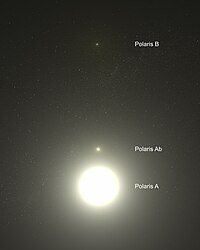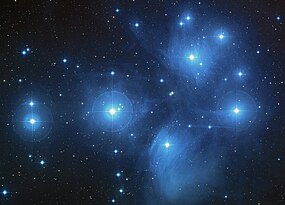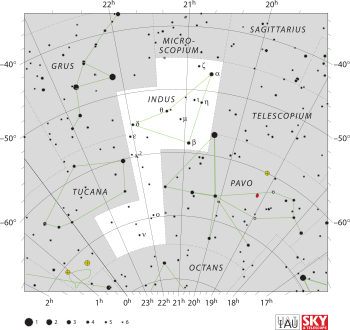Portal:Stars
IntroductionA star is a luminous spheroid of plasma held together by self-gravity. The nearest star to Earth is the Sun. Many other stars are visible to the naked eye at night; their immense distances from Earth make them appear as fixed points of light. The most prominent stars have been categorised into constellations and asterisms, and many of the brightest stars have proper names. Astronomers have assembled star catalogues that identify the known stars and provide standardized stellar designations. The observable universe contains an estimated 1022 to 1024 stars. Only about 4,000 of these stars are visible to the naked eye—all within the Milky Way galaxy. A star's life begins with the gravitational collapse of a gaseous nebula of material largely comprising hydrogen, helium, and trace heavier elements. Its total mass mainly determines its evolution and eventual fate. A star shines for most of its active life due to the thermonuclear fusion of hydrogen into helium in its core. This process releases energy that traverses the star's interior and radiates into outer space. At the end of a star's lifetime as a fusor, its core becomes a stellar remnant: a white dwarf, a neutron star, or—if it is sufficiently massive—a black hole. Stellar nucleosynthesis in stars or their remnants creates almost all naturally occurring chemical elements heavier than lithium. Stellar mass loss or supernova explosions return chemically enriched material to the interstellar medium. These elements are then recycled into new stars. Astronomers can determine stellar properties—including mass, age, metallicity (chemical composition), variability, distance, and motion through space—by carrying out observations of a star's apparent brightness, spectrum, and changes in its position in the sky over time. Stars can form orbital systems with other astronomical objects, as in planetary systems and star systems with two or more stars. When two such stars orbit closely, their gravitational interaction can significantly impact their evolution. Stars can form part of a much larger gravitationally bound structure, such as a star cluster or a galaxy. (Full article...) Selected star - Photo credit: NASA/ESA/HST
Polaris (α UMi / α Ursae Minoris / Alpha Ursae Minoris, commonly North(ern) Star or Pole Star, or Dhruva Tara and sometimes Lodestar) is the brightest star in the constellation Ursa Minor. It is very close to the north celestial pole (42′ away as of 2006[update], making it the current northern pole star. Polaris is about 430 light-years from Earth and is a multiple star. α UMi A is a six solar massWieland page 3: masses of A and P ... (6.0+1.54M⊙) F7 bright giant (II) or supergiant (Ib). The two smaller companions are: α UMi B, a 1.5 solar mass F3V main sequence star orbiting at a distance of 2400 AU, and α UMi Ab, a very close dwarf with an 18.5 AU radius orbit. There are also two distant components α UMi C and α UMi D. Recent observations show that Polaris may be part of a loose open cluster of type A and F stars. Polaris B can be seen even with a modest telescope and was first noticed by William Herschel in 1780. In 1929, it was discovered by examining the spectrum of Polaris A that it had another very close dwarf companion (variously α UMi P, α UMi a or α UMi Ab), which had been theorized in earlier observations (Moore, J.H and Kholodovsky, E. A.). In January 2006, NASA released images from the Hubble telescope, directly showing all three members of the Polaris ternary system. The nearer dwarf star is in an orbit of only 18.5 AU (2.8 billion km; about the distance from our Sun to Uranus) from Polaris A, explaining why its light is swamped by its close and much brighter companion. Polaris is a classic Population I Cepheid variable (although, it was once thought to be Population II due to its high galactic latitude). Selected article - Photo credit: NASA, ESA, AURA/Caltech, Palomar Observatory
In astronomy, the Pleiades, or Seven Sisters (Messier object 45), is an open star cluster containing middle-aged hot B-type stars located in the constellation of Taurus. It is among the nearest star clusters to Earth and is the cluster most obvious to the naked eye in the night sky. Pleiades has several meanings in different cultures and traditions. The cluster is dominated by hot blue and extremely luminous stars that have formed within the last 100 million years. Dust that forms a faint reflection nebulosity around the brightest stars was thought at first to be left over from the formation of the cluster (hence the alternate name Maia Nebula after the star Maia), but is now known to be an unrelated dust cloud in the interstellar medium that the stars are currently passing through. Astronomers estimate that the cluster will survive for about another 250 million years, after which it will disperse due to gravitational interactions with its galactic neighborhood. The Pleiades are a prominent sight in winter in the Northern Hemisphere and in summer in the Southern Hemisphere, and have been known since antiquity to cultures all around the world, including the Māori (who call them Matariki) and Australian Aborigines, the Persians (who called them Parveen/parvin and Sorayya), the Chinese, the Maya (who called them Tzab-ek), the Aztec (Tianquiztli), and the Sioux and Cherokee of North America. Selected image - Photo credit: IAU and Sky & Telescope magazine
Indus is a constellation in the southern sky. Created in the late sixteenth century, it represents an Indian, a word that could refer at the time to any native of Asia or the Americas. Did you know?
SubcategoriesTo display all subcategories click on the ►
Selected biography - Photo credit: NASA
Stephen William Hawking, CH, CBE, FRS, FRSA (8 January 1942 – 14 March 2018) was an English theoretical physicist, cosmologist, and author who was director of research at the Centre for Theoretical Cosmology at the University of Cambridge. Between 1979 and 2009, he was the Lucasian Professor of Mathematics at Cambridge, widely viewed as one of the most prestigious academic posts in the world. Hawking was born in Oxford into a family of physicians. In October 1959, at the age of 17, he began his university education at University College, Oxford, where he received a first-class BA degree in physics. In October 1962, he began his graduate work at Trinity Hall, Cambridge, where, in March 1966, he obtained his PhD degree in applied mathematics and theoretical physics, specialising in general relativity and cosmology. In 1963, at age 21, Hawking was diagnosed with an early-onset slow-progressing form of motor neurone disease that gradually, over decades, paralysed him. After the loss of his speech, he communicated through a speech-generating device initially through use of a handheld switch, and eventually by using a single cheek muscle. Hawking's scientific works included a collaboration with Roger Penrose on gravitational singularity theorems in the framework of general relativity, and the theoretical prediction that black holes emit radiation, often called Hawking radiation. Initially, Hawking radiation was controversial. By the late 1970s, and following the publication of further research, the discovery was widely accepted as a major breakthrough in theoretical physics. Hawking was the first to set out a theory of cosmology explained by a union of the general theory of relativity and quantum mechanics. He was a vigorous supporter of the many-worlds interpretation of quantum mechanics. Hawking achieved commercial success with several works of popular science in which he discussed his theories and cosmology in general. His book A Brief History of Time appeared on the Sunday Times bestseller list for a record-breaking 237 weeks. Hawking was a Fellow of the Royal Society, a lifetime member of the Pontifical Academy of Sciences, and a recipient of the Presidential Medal of Freedom, the highest civilian award in the United States. In 2002, Hawking was ranked number 25 in the BBC's poll of the 100 Greatest Britons. He died in 2018 at the age of 76, having lived more than 50 years following his diagnosis of motor neurone disease. (Full article...) TopicsThings to do
Related portalsAssociated WikimediaThe following Wikimedia Foundation sister projects provide more on this subject:
Discover Wikipedia using portals |

























